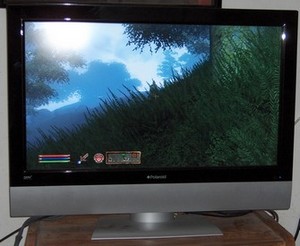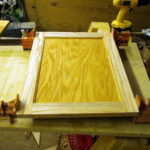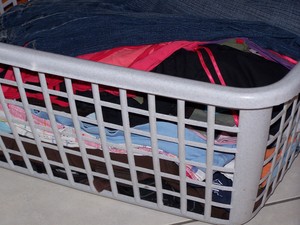My initial experience with the Polaroid FLM-3232 LCD TV was one of sheer frustration because I ended up returning three of them before I got one that I considered to be free of defects. This means one of two things: either I’ve reached an obsessive-compulsive level of nitpicking, or Polaroid needs to implement some stronger quality control standards. In the interest of fairness, I will evaluate the fourth (and hopefully, final) unit, and discuss the defects of the first three afterwards.
The Polaroid FLM-3232 is a 32-inch wide screen LCD flat panel TV that doubles as a computer monitor. It has a resolution of 1366×768, and a contrast ratio of 800:1. It supports 480p, 480i, 720p, and 1080i resolutions. It has both a standard-definition and a high-definition tuner built in. The television has an impressive array of inputs and outputs. There is an HDMI input, 2 component video inputs, 2 RCA inputs, an S-video input, and a VGA monitor input. There is also a headphone jack, stereo audio output, a coaxial audio output, and a digital audio output. These are all located on the back of the unit, except for the headphone jack and one of the RCA inputs, which are on the right side.
The unit weighs in at a very manageable 47 pounds, and is approximately 25 inches high, 32 inches wide, and just a few inches in depth from front to back. The box includes the TV, a metal stand with a screwdriver and screws, a remote with batteries, an instruction manual, a quick-start guide, a power cord, and a bag of AV cables. Setup should take about 20 minutes, tops.
Aesthetically, the FLM-3232 is an attractive unit. The viewable screen is framed by a glossy black border, which is stamped at the bottom with the Polaroid emblem and an HDTV logo. There is a small LED light in the corner which is blue when the TV is on, and a rather intense orange when the unit is off. The speakers are located at the bottom of the unit, and are covered with a silver metallic grille. Placing the speakers at the bottom was a wise move on Polaroid’s part. It’s more practical, and it simply looks better than the many units that add unnecessary width by framing the screen with wing-like side speakers. Though the unit can be wall-mounted, it comes with a sturdy metal stand, which is also silver. The right side of the television has power, volume, channel, and menu buttons, which are handy in case the remote gets lost. The FLM-3232 is slim and sexy, with a clean, space-age appearance. It will look good wherever you put it.
The stereo sound on this set is adequate. It was a bit tinny on the default settings, but fortunately the bass and treble levels can be adjusted through the menu. I turned the bass up and the treble down, and it sounded better. The sound options include special effects like simulated surround, as well as equalizers like “Pop,” “Classic,” “Techno,” etc. But I found that these settings made everything sound tinny and unnatural, so I set the sound effects to “off.” As I mentioned earlier, the TV has 3 different sound outputs on the back, so external speakers can be hooked up easily. It goes without saying that the two 10-Watt internal speakers won’t compare to a powerful surround system, so this may be a logical next purchase for audiophiles looking to beef up their home theater systems.
The most important feature on a television is its picture. This unit’s picture is one of the factors that attracted me, along with its price. I spent a considerable amount of time conducting side-by-side comparisons of all the LCD televisions in the store. The Polaroid FLM-3232 looked as good as (and in some cases better than) the bigger brand names, which cost hundreds of dollars more. Overall, the unit is capable of sharp images and vivid colors. The whites are bright and clean. Black levels are less than perfect, though. When the screen is entirely black (or very dark), there is a noticeable silvery sheen. It should be noted, however, that displaying true black levels is problematic for all LCD TVs.
There are a number of preset picture modes, such as “Cinema,” “Hi-Bright,” and “Sport.” I found these to be largely useless. Some have the color saturation set too high, so that reds and greens are painfully intense. Others have it set too low, so that the picture looks dull and washed out. The Cinema setting makes the picture way too dark. For best results, you will need to create a custom picture mode and adjust all of the picture settings individually to find the sweet spot. And that sweet spot may vary based on the input device being displayed. Fortunately, you can configure, adjust, and save a custom picture setting for every type of input. An extremely important thing to keep in mind about this, or any other HDTV, is that the picture quality will only be as good as its input source.
Watching TV with the FLM-3232’s standard-definition tuner is not a pleasant experience. Even the strongest signals appear in a haze of static, and the images look unnaturally stretched out. The high-definition tuner, however, is another story. The picture on these channels is crisp, clean, and completely static-free. Shows broadcast in true high-definition are stunning in their level of clarity. Small and sometimes unflattering details become apparent, like lines and blemishes on celebrities’ faces, and debris floating in aquarium tanks. One thing I noticed about the HD channels is that when the image pans or scrolls very quickly, or when very fast movement like a waterfall is shown, there is some blurring and “artifacting” on the screen. Artifacting refers to the small clusters of scrambled-looking pixels that suggest that the screen can’t quite keep up with the movement. On the whole, though, this TV is more than capable of delivering a satisfying high-definition experience. I look forward to testing it with cable or satellite TV.
The built-in HD tuner is worth discussing in-depth, as it is a feature sometimes absent from other televisions in this price range. While external HD tuners can be purchased separately, they run over $200, which makes this a feature to consider when buying an HDTV. All you need to receive HD stations with this television is a standard coaxial antenna. The television can automatically scan for channels. I now receive HD versions of all the local channels I had on my old TV, plus a few new stations, which are mostly PBS affiliates. One of these stations broadcasts programs in 1080i high-definition all the time, while others only broadcast in 1080i for certain shows, like the Tonight Show, and CSI. Needless to say, these programs look amazingly sharp and clear. Some other channels broadcast in 720p high-definition, which usually means that the image is made into a square and centered, with black bars running vertically up the sides of the screen, much like letterboxing. Still other channels broadcast in standard-definition, 480i. These channels look decent, though a bit grainy and not nearly as sharp as their HD counterparts. I’ve been spoiled by the image quality of high-definition television, and I would be reluctant to purchase another TV without an HD tuner, especially with networks switching to digital broadcasting in the next few years. The main drawback to over-the-air HD is that when reception is poor, the audio and video tend to intermittently freeze, and colored squares (commonly known as “garbage” in computer lingo) appear on the screen. This is annoying, but can be fixed by adjusting the antenna.
Watching movies is quite satisfying on this TV. I used a Samsung DVD player with HDMI, component video, and RCA outputs. I tried all of them, using scenes from Revenge of the Sith as a point of reference. The results were surprising. Component video actually fared the worst, as the picture had an unpleasant, greenish tint. I was actually hard-pressed to tell the difference in quality between the all-digital HDMI, and the rather old-fashioned RCA connections. This is to say that both were very clear, and both made minor details apparent, such as the coarse texture of Yoda’s robe. I did not notice any artifacting, even in very fast-moving scenes. For this reason, the visual quality of the DVD actually exceeded that of high-definition television programming. These results are consistent with other movies I’ve watched since I’ve purchased this television, though it should be noted that not all DVDs look as good as Revenge of the Sith.
The FLM-3232 serves as a capable PC monitor. The image is sharp with vivid colors, and the unit does not suffer from the fuzziness and “ghosting” that plague some LCD monitors. This TV can be connected to a computer via a male-to-male VGA cable, or through a male-to-male DVI-to-HDMI cable. Surprisingly, I had better results with the former. When using the HDMI connection, I noticed some “shimmering” pixels on my desktop and in certain images. In any case, the unit is a bit finicky about what resolutions it will accept. When switching between resolutions, I would occasionally get a blue screen with the words “Not Support” flashed at the top, and would have to restart the computer. Many different resolutions are available depending on your video card. Overall, I found that 1024×768 and lower resolutions give the screen a “squashed down” look, while 1080×768 and higher resolutions look natural, though text becomes small and difficult to read. My PC only recognizes this TV as a “default monitor.” I suspect that I might have better luck with the resolutions if Polaroid were to release a specific display driver on its website. I would recommend this unit for PC gaming, movie watching and image viewing, but not for word processing or other text applications.
My primary use for this television is console gaming. So how does the FLM-3232 fare in this department? The results are a mixed bag. In short, the unit looks stunning for games that were designed to take advantage of a high-definition TV. My Xbox 360 looks exceptionally good with component video cables. A component connection with the original Xbox system yields impressive results for select games, mostly those that support 720p resolution. Other Xbox games look clear, with vibrant colors, but textures and objects may suffer from very noticeable jagged edges. The standard RCA cables are a better option for such games, as they make the screen slightly “fuzzier” while smoothing out edges.
I was heartbroken to see that even the most visually advanced Nintendo Gamecube games look fairly fuzzy and out of focus, with jagged edges when played on this TV. The same holds true for Playstation 2 games. I must emphasize that this problem is not the fault of the TV. The sad truth is that Gamecube, Playstation 2, and many Xbox games display at low resolutions. Stretching the image out on a large, widescreen television tends to magnify defects that are masked by the small screen size and low pixel count of regular televisions. It’s like magnifying an image from a newspaper; it will become larger, but it will lose clarity and become pixelated. This problem can be remedied somewhat by changing the screen’s aspect ratio with the “Aspect” button on the remote. The “Normal” mode will “shrink” the screen so that only a square portion in the center is used as viewable space. The smaller screen will make jagged edges and pixelation less noticeable. Also, as counterintuitive as this may seem, I found that all games regardless of system or input type look much better with the television’s sharpness setting turned down to zero. For some reason a high sharpness setting gives game graphics a “flaky” texture, laden with white dots.
It is worth mentioning that this TV has an excellent “Picture in Picture” mode, which allows you watch two input sources simultaneously. You can view them side-by-side, or with one in a small window. There is also a sleep timer, so you can program the TV to turn itself off – or on – at a specific time. Another handy feature is the “Guide” button on the remote, which pulls up a schedule of the day’s programs for any given channel, and features information on each.
And now for a brief account of my experience returning 3 defective FLM-3232 units. Once the initial euphoria of having a decent-sized LCD television wore off, I noticed a bright spot in the upper-left corner whenever the screen was black, or any other dark color. The spot wasn’t pure white, as with a cluster of dead pixels, but rather bleached-out looking, as if the brightness were set too high, but only in that area of the screen. It wasn’t a huge deal, but the floor model didn’t have this problem, so I decided to exchange it for another one. The second one had small bright spots in several corners, but the problem was much less pronounced and distracting than on the first, and I was prepared to live with it. After a week, though, the TV began to randomly emit a very loud buzzing sound, like a neon sign. It was coming from the back, and may have indicated a problem with the fluorescent light tubes that backlight the screen. This was very obnoxious, so I exchanged the set for a third. This was perhaps the worst unit of all; it had several large bright spots, and this time they were located symmetrically near the center of the screen on both sides. It was maddening. I couldn’t watch any movie or play any game without noticing those “hotspots” where the dark colors were bleached out. I strongly considered either trading up for another brand, or just getting my money back. But the other brands with the same features cost about $600 more, so I decided I’d try one last time. My fourth FLM-3232 has worked well for over two months. The black levels are uniform, and I have yet to notice any strange sounds, or picture anomalies. But it was a frustrating experience, overall. In Polaroid’s defense, a co-worker formerly employed at a major electronics store told me that large televisions are often dropped, handled roughly, and improperly stored in stockrooms. I’m not sure whether this was the case with the three defective televisions I returned, or if the entire product line has some problems that need to be addressed. In any case, I’m glad I purchased the extended warranty.
All in all, there is a lot to like about Polaroid’s FLM-3232 television. It has just about any input you could possibly want. And you can have several input devices hooked up simultaneously and toggle between them with the remote, while maintaining custom settings for each. You can also change the screen’s aspect ratio on the fly with a remote button. The guide, picture-in-picture, and sleep timer are all handy as well. And the built-in HD tuner is a must-have feature. Image quality is clear and beautiful for the most part, with colors that are bright and vivid after you’ve tweaked the picture settings to your liking. Movies and newer video games look great on this set. The sound is satisfactory, and the ability to use the TV as a giant computer monitor is a great plus.
On the downside, we have a standard-definition tuner that doesn’t work very well, and a black level that could be darker. And while the latest and greatest video games look extraordinary on this set, older, low-resolution games are magnified to the point where they become pixelated, with jagged edges. Note that these three problems are actually very common among larger LCD televisions, and are not specific to this unit. Another small problem is the artifacting that occurs with fast panning or scrolling on high-definition channels. And one minor cosmetic gripe I have is that the orange standby light looks as bright as a laser pointer in the dark, so that I actually have to cover it when I go to bed. Potential buyers should also be aware that, if my experiences are any indication, there might be some defective units floating around in retail outlets. But if you can get one that works properly, I don’t think you’ll be disappointed; with its $900 -$1000 price tag, the FLM-3232 delivers a considerable bang for your buck.







